Others - Classical antiquity - Fotogalerie - Sold antiquities
Archive of sold antiquities
All artefacts sold in our gallery are fully documented in our online archive and database. Being a specialist ancient art dealer, preserving also the more recent history of each and every piece sold in our shop is at our heart. That is particularly useful for artefacts that changed owners in the meantime. Information that may have been lost in the process can be easily restored from our archives. Please do not hesitate to contact us if you need further information about ancient items that have been sold in our gallery. We can help you with reconstructing the history of ownership for those items. All information about our customers will be kept confidential, of course.-
 Roman Celtic seal box
Roman Celtic seal boxLozenge shaped body with lid in Celtic design. A piece from the 1st or 2nd century, found near the Celtic settlement and later Roman town of Lindum. Published in a standard work by Richard Hattatt.
Price: on request Roman seal box
Roman seal boxPiriform body with engraved cross on the lid. A piece from the Roman Imperial period. Published in a standard work by Richard Hattatt.
Price: on request Roman seal box
Roman seal boxPiriform body with engraved bird on the lid. A piece from the Roman Imperial period, found near Dover. Published in a standard work by Richard Hattatt.
Price: on request Roman seal box with phallus
Roman seal box with phallusCircular body with protective phallus in high relief on the lid. A piece from the Roman Imperial period, found in North East England. Published in a standard work by Richard Hattatt.
Price: on request Ancient ladle with donkey head terminal
Ancient ladle with donkey head terminalElegant long bronze ladle, from the Greek or Etruscan culture. 5th to 4th century BC.
Price: on request Egyptian coffin with snake
Egyptian coffin with snakeThe small bronze votive box is modelled on top with a coiled serpent. The artefact was probably made around 400 BC in Naukratis to be devoted to Atum.
Price: on request Ancient ladle with bird head terminal
Ancient ladle with bird head terminalElegant long bronze ladle, from the Greek or Etruscan culture. 5th to 4th century BC.
Price: on request Base plate of a Roman mirror
Base plate of a Roman mirrorThe bronze disc is the base plate of a Roman mirror. A handle and reflective metal coating were once part of the mirror. Typical for upper class Roman households during Imperial times.
Price: on request Jama-Coaque roller stamp
Jama-Coaque roller stampClay roller stamp with relief of plants to be applied as skin decoration. This tool was used in the early phase of the ecuadorian Jama-Coaque culture.
Price: on request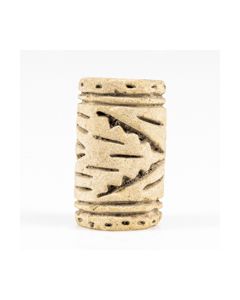 Jama-Coaque roller stamp
Jama-Coaque roller stampClay roller stamp with relief of stylized plants used to apply skin decoration. This tool is from the early phase of the ecuadorian Jama-Coaque culture.
Price: on request Egyptian mummy cartonnage
Egyptian mummy cartonnageCentral piece of a mummy cartonnage from the ptolemaic period. Covered with polychrome paint giving an interesting insight into ancient Egyptian funerary rituals. Probably originating from Akhmim in Upper Egypt.
Price: on request Egyptian mummy cartonnage from Thebes
Egyptian mummy cartonnage from ThebesChest and leg piece of a mummy cartonnage from the ptolemaic period. Covered with polychrome paintings giving an interesting insight into ancient Egyptian funerary rituals.
Price: on request Appliqué of the Horus Son Imsety
Appliqué of the Horus Son ImsetyWonderful bichrome faience from the 30th dynasty or slightly later. Deaccessioned from an old museum lending collection.
Price: on request Jama-Coaque roller stamp
Jama-Coaque roller stampClay roller stamp with relief of mythological creatures to be applied as a skin decoration. This tool was used in the early phase of the ecuadorian Jama-Coaque culture and was found in Pedernales.
Price: on request Jama-Coaque roller stamp
Jama-Coaque roller stampClay roller stamp with rich ornamental relief to apply skin decoration. This tool was used in the early phase of the ecuadorian Jama-Coaque culture.
Price: on request Roman mirror from Baalbek
Roman mirror from BaalbekThe bronze disc is the base plate of a bronze mirror, that was once attached to a handle and coated with a reflective metal layer. Typical for upper class Roman households during Imperial times.
Price: on request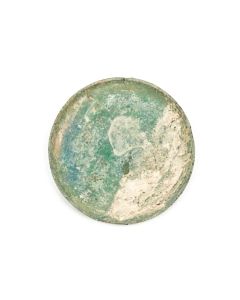 Roman mirror from Baalbek
Roman mirror from BaalbekThe bronze disc is the base plate of a bronze mirror, that was once attached to a handle and coated with a reflective metal layer. Typical for upper class Roman households during Imperial times.
Price: on request Ptolemaic sarcophagus mask
Ptolemaic sarcophagus maskImpressive wood relief of an idealized face. Remains of paint. The mask was part of a sarcophagus lid from Ancient Egypt during ptolemaic rule.
Price: on request Roman military whistle
Roman military whistleHistorically interesting example of Roman military equipment. Whistles of this type have been used in the 1st to 2nd cent. AD. Their function is not fully understood, yet.
Price: on request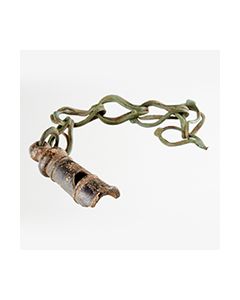 Roman military whistle
Roman military whistleHistorically interesting example of Roman military equipment. Whistles of this type have been used in the 1st to 2nd cent. AD. Their function is not fully understood, yet.
Price: on request Kleine griechische Olpe
Kleine griechische OlpeMiniaturausführung eines griechischen Kännchens. Möglicherweise Votivkeramik oder Spielzeug. Klassische Epoche, etwa 4. Jh. v.Chr., rot-schwarze Glasur, rote Bemaltung.
Price: on request römische Beschläge aus Bronze
römische Beschläge aus BronzeLot aus 5 Kleinbronzen, perfekt erhalten mit schöner Patina. Aus alter deutscher Sammlung.
Price: on request Griechische Kylix, Magna Grecia
Griechische Kylix, Magna GreciaKleiner Kelch mit nur einem Henkel. Halbkugelartige Form. Heller Ton m. schwarzem Überzug.
Price: on request Gruppe 5 antiker Gürtelschnallen
Gruppe 5 antiker GürtelschnallenRömische Gürtelschnallen aus Bronze. Etwa 1. bis 6. Jh. n. Chr., diverse Ausführungen. Pannonische Provinzen.
Price: on request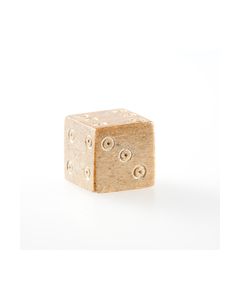 Römischer Würfel aus Bein
Römischer Würfel aus BeinGroßer römischer Würfel aus Bein, 1. Jhd.n.Chr. Mit attraktiver, dunkler Tönung.
Price: on request Römischer Würfel aus Bein
Römischer Würfel aus BeinGroßer römischer Würfel aus Bein, 1. Jhd.n.Chr. Mit attraktiver, dunkler Tönung.
Price: on request Römischer Würfel aus Bein
Römischer Würfel aus BeinGroßer römischer Würfel aus Bein, 1. Jhd.n.Chr. Mit attraktiver, dunkler Tönung.
Price: on request Römisches Tonsieb
Römisches TonsiebRotes Terracotta, außen verziert durch Zierrillen, breiter Henkel.
Price: on request Mühlespielbrett aus einer Hypokaustanlage mit Stempel
Mühlespielbrett aus einer Hypokaustanlage mit StempelDas Stück stellt ein Unikat dar. Die Stempellesung ist unbekannt, ebenso wie Vergleichsstücke in der Forschungsliteratur.
Price: on request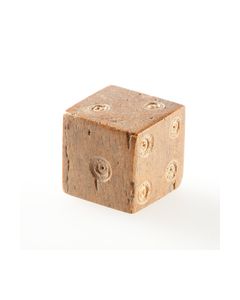 Römischer Würfel aus Bein
Römischer Würfel aus BeinGroßer römischer Würfel aus Bein, 1. Jhd.n.Chr. Mit attraktiver, dunkler Tönung.
Price: on request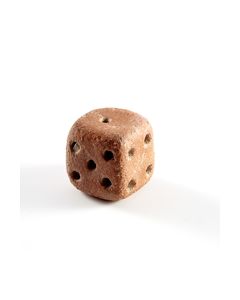 Römischer Würfel aus Stein
Römischer Würfel aus SteinCa. 1. bis 4. Jh. n. Chr., Summen der Gegenüberseiten 4, 6, 11.Ca. 16mm Kantenlänge.
Price: on request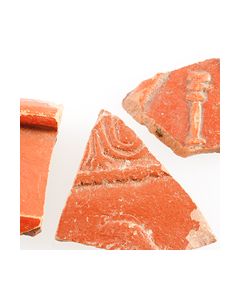 Gruppe von 3 Terra Sigillata-Fragmenten
Gruppe von 3 Terra Sigillata-FragmentenRömisch, 1. bis 3. Jh. n.Chr., Provinzen Germania, Scherben von Keramik mit rotem Glanzton-Überzug (Engobe). Bemerkenswert sind die erhaltenen Dekorationselemente.
Price: on request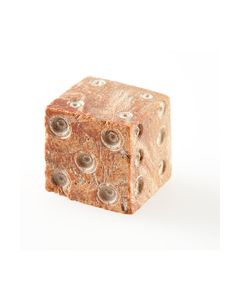 Römischer Würfel aus Bein
Römischer Würfel aus BeinGroßer römischer Würfel aus Bein, 1. Jhd.n.Chr. Mit attraktiver, dunkler Tönung.
Price: on request Römischer Würfel aus Bein
Römischer Würfel aus BeinGroßer römischer Würfel aus Bein, 1. Jhd.n.Chr. Mit attraktiver, dunkler Tönung.
Price: on request Römischer Würfel aus Bein
Römischer Würfel aus BeinGroßer römischer Würfel aus Bein, 1. Jhd.n.Chr. Mit attraktiver, dunkler Tönung.
Price: on request Römischer Würfel aus Bein
Römischer Würfel aus BeinGroßer römischer Würfel aus Bein, 1. Jhd.n.Chr. Mit attraktiver, dunkler Tönung.
Price: on request

